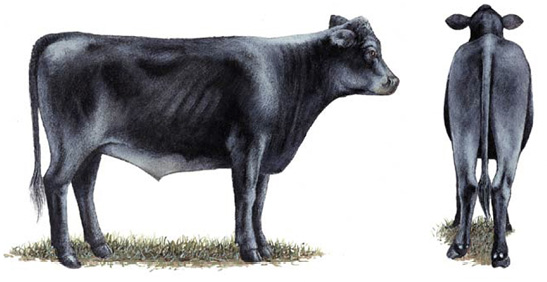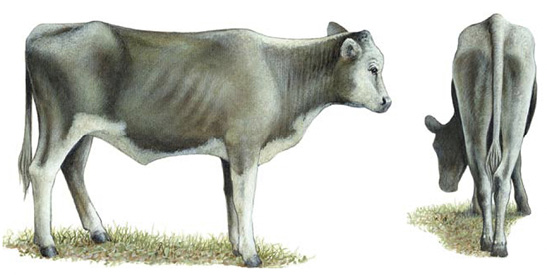Grading Feeder Cattle
For many, the standard language used to describe groups of feeder cattle may seem like a foreign language. However, the feeder calf grading system provides a common language between buyers and sellers of feeder cattle. The standards, initially released in 1979, were most recently updated in October 2000 to reflect changes to the U.S. cowherd. In addition, these grades provide a common language used in USDA cattle market reports.
Feeder calf grades are based on frame size and muscle thickness, which correspond to an anticipated slaughter weight. These two characteristics are critical factors that affect calf value. Frame size is tied very closely to finished weight and is a genetically inherited trait that is not greatly affected by normal management practices. It is expected that, under typical feeding and management conditions, large-framed animals will require more time on feed to reach the choice grade than small-framed animals, and that large-framed cattle will weigh more at the same quality grade. The muscle thickness score is related to lean and fat composition of the carcass, with thick-muscled animals (lower muscling score) expected to produce more lean meat.
There are 12 possible combinations of feeder calf grades from the three frame size grades and four muscle grades. Often these combinations of grades are reported using an abbreviated format. For example, an L1 refers to an animal with a large frame and No. 1 muscle thickness. In addition to the standard grades, there is an “inferior” category for unthrifty cattle. These unthrifty cattle may have issues related to disease, mismanagement, parasites, or simply poor nutrition. Double-muscled cattle are also included in this inferior grade, as they simply do not produce enough marbling to reach the choice grade.
Frame size should be determined in relation to a calf’s age, with appearance generally used to estimate the age of cattle of unknown origin. As cattle grow older, several telltale signs indicate age: ears decrease in size relative to a calf’s head, muzzle becomes wider, head becomes longer relative to its width, and tail is longer with a more prominent switch.
Since fat can alter the amount of muscle a calf appears to have, muscle thickness should be appraised at a constant fatness, when cattle are slightly thin. If a calf has more external fat cover, the muscle score should be determined as if he possessed a slightly thin fat cover.
Frame Size Standards
Large Frame (L)
Thrifty cattle have large frames and are tall and long-bodied for their age. Steers and heifers would not be expected to produce U.S. Choice carcasses (approximately 0.50 inches of fat at 12th rib) until their live weights exceed 1,250 pounds and 1,150 pounds, respectively.
Medium Frame (M)
Thrifty cattle have slightly large frames and are slightly tall and slightly long-bodied for their age. Steers and heifers would be expected to produce U.S. Choice carcasses at live weights of 1,100–1,250 pounds and 1,000–1,150 pounds, respectively.
Small Frame (S)
Thrifty cattle have small frames and are shorter bodied and not as tall as specified as the minimum for the medium frame grade. Steers and heifers would be expected to produce U.S. Choice carcasses at live weights of less than 1,100 pounds and 1,000 pounds, respectively.
|
Frame |
Steers (lb) |
Heifers (lb) |
|---|---|---|
|
Large |
1,250 |
1,150 |
|
Medium |
1,100 |
1,000 |
|
Small |
<1,100 |
<1,000 |
Muscle Thickness Standards
No. 1
Feeder cattle that possess minimum qualifications for this grade predominate beef breeding. They must be thrifty and moderately thick throughout. They are moderately thick and full in the forearm and gaskin, showing a rounded appearance through the back and loin with moderate width between the legs, both front and rear. Cattle show this thickness with a slightly thin covering of fat; however, cattle eligible for this grade may carry varying degrees of fat.

No. 2
Feeder cattle that possess minimum qualifications for this grade show a high proportion of beef breeding, and slight dairy breeding may be detected. They must be thrifty and tend to be slightly thick throughout. They tend to be slightly thick and full in the forearm and gaskin, showing a rounded appearance through the back and loin with slight width between the legs, both front and rear. Cattle show this thickness with a slightly thin covering of fat; however, cattle eligible for this grade may carry varying degrees of fat.

No. 3
Feeder cattle that possess minimum qualifications for this grade are thrifty and thin through the forequarter and the middle part of the rounds. The forearm and gaskin are thin, and the back and loin have a sunken appearance. The legs are set close together, both front and rear. Cattle show this narrowness with a slightly thin covering of fat; however, cattle eligible for this grade may carry varying degrees of fat.

No. 4
Feeder cattle included in this grade are thrifty animals that have less thickness than the minimum requirements specified for the No. 3 grade. This grade is typically made up of dairy cross cattle.

Summary
The USDA feeder cattle grading system is a great tool for producers. It provides buyers and sellers with a common language to describe cattle that may be sight-unseen, and it also offers cow-calf or stocker producers a method to evaluate a group of calves and estimate their future performance. Feeder calf grades are the standard by which livestock market reports are based. These grades also allow for better sorting of cattle into more uniform groups for finishing. This tool can allow producers at the start of the beef production chain to evaluate their breeding and management programs to more closely match the market they are trying to fit.
For more information about beef cattle production, contact your local county MSU Extension office or visit the Extension Beef page.
References
USDA Agricultural Marketing Service. (2000). Feeder cattle grades and standards.
USDA Agricultural Marketing Service (2000). U.S. standards for grades of feeder cattle. Publication AMS-586.
Publication 3580 (POD-04-24)
By Brandi B. Karisch, PhD, Extension Beef Cattle Specialist and Associate Extension/Research Professor, Animal and Dairy Sciences.
The Mississippi State University Extension Service is working to ensure all web content is accessible to all users. If you need assistance accessing any of our content, please email the webteam or call 662-325-2262.




